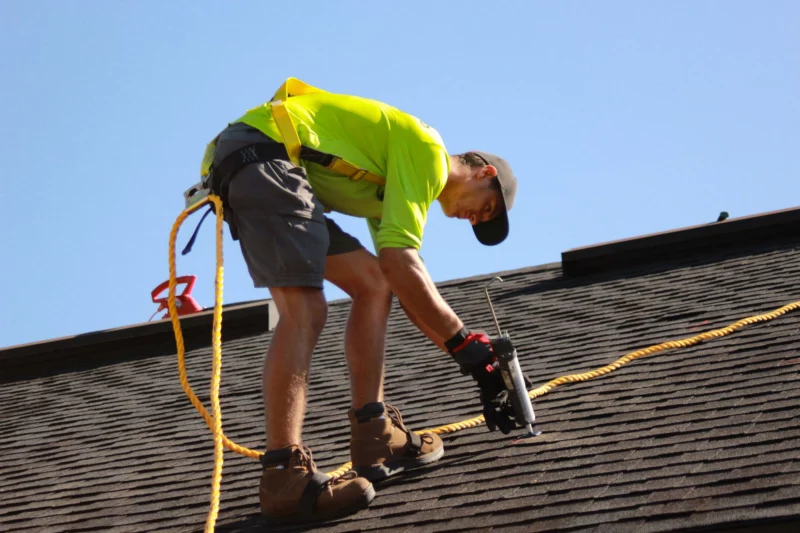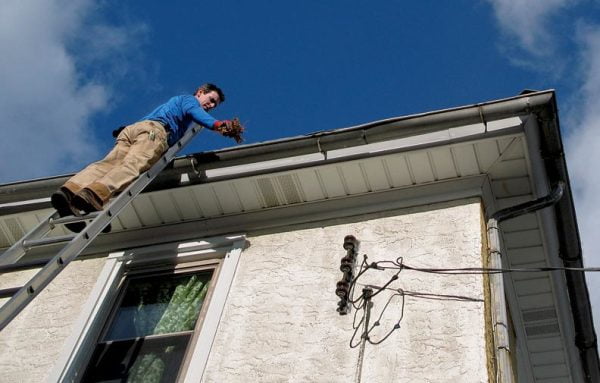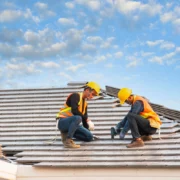Roofing is a critical aspect of home maintenance, yet it often goes overlooked until problems arise. For homeowners, understanding the basics of roofing safety is essential, especially in areas like New Jersey where the weather can be unpredictable, affecting roofing conditions and safety.
From harsh winters to humid summers, these weather extremes pose unique challenges and risks during roofing work. This article provides essential guidelines to help homeowners navigate the complexities of roofing maintenance safely, ensuring their well-being and the longevity of their homes.
Understanding Roof Slope and Stability

The slope and stability of your roof play a critical role in safety. Steep roofs present a higher risk of falls and require additional safety measures like roofing jacks or a scaffold system. Before beginning any work, assess your roof’s slope and stability.
Take extra precautions on roofs with moss or algae, as they can be more slippery than they appear. Inform someone about your roofing plans for safety checks. Avoid working on extremely steep roofs without professional help. It’s always better to err on the side of caution and use additional safety equipment on sloped surfaces.
Being Aware of Roofing Risks
Awareness of the inherent risks in roofing work is the first step towards ensuring safety. Roofing involves working at heights, potentially around power lines, and handling heavy materials, all of which carry risks of falls, electrical shocks, and physical injury.
In regions like New Jersey, where weather conditions can change rapidly, these risks can be amplified. Homeowners should assess these risks thoroughly and consider consulting a New Jersey roofing company for tasks that seem too hazardous to handle alone.
Proper Safety Equipment

Equipping oneself with the right safety gear is crucial in minimizing the risks associated with roofing work. Essential safety equipment includes a sturdy ladder, non-slip boots, gloves, safety goggles, and a harness for steep or high roofs.
These tools not only provide physical protection but also give homeowners the confidence to perform roofing tasks more safely and effectively. Wearing a long-sleeved shirt and durable pants can protect against scrapes and cuts.
Always check the condition of your safety gear before use, ensuring there are no damages or faults. A helmet can also be a valuable addition, especially when working under potentially loose materials.
Safe Ladder Use and Placement

Ladders are indispensable in roofing work, but they also account for a significant number of accidents. Proper use and placement of ladders are key to safety.
The ladder should be placed on a firm, level surface, and it should extend at least three feet above the edge of the roof for stability. Always face the ladder while climbing and avoid overreaching, which can cause the ladder to tip.
Make sure the ladder’s angle is approximately 75 degrees from the ground for optimal stability. Inspect the ladder for any wear or damage before each use. Using ladder stabilizers can provide additional safety and prevent damage to gutters.
Working With Electricity Safely
Electricity poses a significant hazard during roofing work. Always be aware of overhead power lines and keep ladders, tools, and yourself at a safe distance from them.
If your roofing work is near any electrical wires, it’s advisable to contact a professional to handle the task or to shut off the power temporarily for safety. Use non-conductive ladders, such as those made of fiberglass, to further reduce the risk of electrical shock.
Wearing rubber-soled shoes can add an extra layer of protection. Never attempt to touch or handle electrical wires directly. A general rule is to always assume that all overhead wires are energized at lethal voltages.
Avoiding and Handling Falls
Falls are the most serious risk in roofing work. Preventing falls starts with using the right equipment, such as safety harnesses and guardrails, especially on steeper or higher roofs.
It’s also essential to be constantly aware of your surroundings and to move cautiously. In case of a fall, knowing how to properly use safety equipment and having a plan for emergency response is vital.
Clear any obstacles on the roof to ensure a safe working path. Take regular breaks to avoid fatigue, which can lead to a loss of concentration. Working with a buddy can ensure immediate help in case of an accident.
Proper Material Handling and Storage
Roofing involves heavy and sometimes bulky materials that require careful handling to avoid injury. Practice proper lifting techniques, keeping your back straight and lifting with your legs.
When storing materials, ensure they are securely placed and won’t slide or shift, potentially causing falls or other accidents. Keep the work area clean and organized to minimize trip hazards.
Use a pulley system or hoist for transporting heavy materials to the roof. Wear gloves to protect your hands from sharp materials. Regularly clean up debris and unused tools from the work area to prevent tripping hazards.
First Aid and Emergency Procedures
Having a basic understanding of first aid and emergency procedures is essential in roofing work. This includes knowing how to treat minor injuries like cuts or abrasions and understanding the steps to take in the event of more serious accidents.
Keeping a first aid kit accessible on the job site and having emergency contact numbers at hand can make a significant difference in response time and effectiveness. In case of an accident, remain calm and call for emergency services immediately.
Always keep a charged phone within reach for urgent communication. Basic first aid training, especially in CPR and wound care, is highly recommended for regular DIY roofers. Familiarize yourself with the quickest route to the nearest hospital or emergency care center.
Conclusion
By following these comprehensive guidelines – from using the proper safety equipment and ensuring safe ladder practices to understanding how to work around electricity and handle roofing materials – homeowners can significantly reduce the risks associated with roofing work.
It’s essential to recognize your limits and know when to seek the expertise of professionals, especially for complex or hazardous tasks. Regular maintenance, coupled with a strong emphasis on safety, can not only extend the lifespan of your roof but also ensure the well-being of those undertaking the work.
Your roof is a key protector of your home, and maintaining it safely is crucial to ensuring your home remains a safe and secure haven. Taking the right precautions will provide peace of mind and safeguard the value and integrity of your property.










Comments